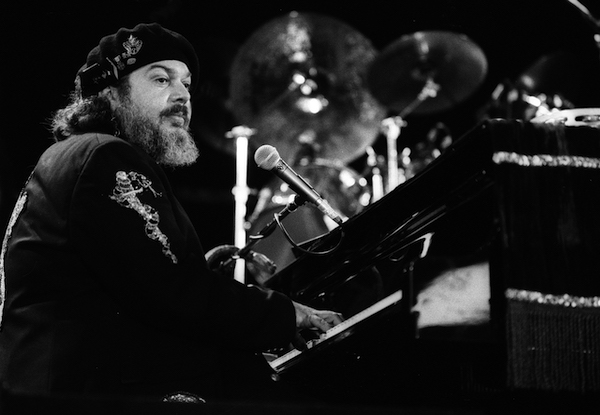Oct 28, 2025 10:47 AM
In Memoriam: Jack DeJohnette, 1942–2025
Jack DeJohnette, a bold and resourceful drummer and NEA Jazz Master who forged a unique vocabulary on the kit over his…

Dr. John (1941–2019)
(Photo: Hyou Vielz)DownBeat devised the term “Beyond” to apply to music that defies easy categorization—and no one is a better example of that than Dr. John.
“Yeah, Mac was ‘beyond’ even when he was still with us,” observed guitarist and Grammy award-winning producer Shane Theriot, who produced Dr. John’s final gift to the world: the last album he recorded and signed off on before his June 6 death at 77.
That as-yet unreleased album, which at press time wasn’t attached to a label, caps a genre-busting career. Steeped in the funky second-line rhythms of his hometown of New Orleans—where he joined a pantheon of piano greats from Professor Longhair to Fats Domino—Dr. John ranged far beyond his roots, without ever losing that deep connection, collecting six Grammys along the way and earning his rightful place in the Rock & Roll Hall of Fame.
Born Malcolm John Rebennack Jr., he was still a kid when he started channeling Pinetop Perkins on the keys and Lightnin’ Hopkins on guitar. As a teen in the mid-’50s, he dove headfirst into the steamy cauldron of r&b boiling over in New Orleans, wrote a couple of regional hits himself, and was touring the South as a guitarist when he sacrificed the tip of one finger to the gods in a Florida motel altercation.
That fortuitous mishap reignited Mac’s uncanny ability to “radiate the 88s,” as he put it, first as a Bourbon Street strip-joint organist and later as Dr. John The Night Tripper, the bone-and-bead bedecked stage persona he unveiled on his 1968 debut, Gris-Gris. Inspired by a Senegalese healer and conjurer who arrived in 19th century New Orleans via Haiti, Dr. John soon became inseparable from Mac himself.
“Mac did incantations and chants before the gigs,” recalled jazz keyboardist and bandleader David Torkanowsky, who played Hammond B-3 with Dr. John on and off for several decades and accompanied Mac every year to get a New Year’s blessing and gris-gris bag from their spiritual mentor, Frank Lastie. “It was sort of a spiritual reset.”
“It wasn’t a jive thing,” noted Theriot, a Neville Brothers veteran who played guitar with Dr. John on before signing on as Mac’s producer. “Everyone would hold hands in a circle, and I always felt different when we got done with that.”
Those spiritual resets carried even more weight when Theriot and Torkanowsky were both working on what they sensed would be Mac’s swan song. And while some fans might be surprised that the as-yet untitled album invokes the spirit of Hank Williams and other country pioneers, taken in context of Mac’s career, it makes perfect sense.
Ske-Dat-De-Dat: The Spirit Of Satch (2014), the last studio album Mac released before his death, salutes Louis Armstrong and follows tributes to Duke Ellington and songwriter Johnny Mercer. Now, Williams joins that illustrious list.
“[T]hose songs were dear to his heart,” said Theriot, who helped Mac fulfill a dream of following Ray Charles’ lead by making his own country album. “This record wasn’t intended to be posthumous; that’s just the way things happened. It was a cohesive artistic statement Mac put together while he was here.”
Like Dr. John’s concerts, the forthcoming album has some surprises. Willie Nelson joined in for a joyous rendition of “(Give Me That) Old-Time Religion” and Rickie Lee Jones circled back to put a spell on “I Walk On Gilded Splinters.” But even the country standards were “completely Rebennack-ed out,” as Torkanowsky put it.
“Mac basically channeled ancestry, which is what great jazz players do,” Torkanowsky said. “Every time you played music with him, you were speaking to several of his ancestral griots at the same time. That’s why his music was so deep. It was informed by history and a deep reverence for those who came before him.” DB

Jack DeJohnette boasted a musical resume that was as long as it was fearsome.
Oct 28, 2025 10:47 AM
Jack DeJohnette, a bold and resourceful drummer and NEA Jazz Master who forged a unique vocabulary on the kit over his…

Goodwin was one of the most acclaimed, successful and influential jazz musicians of his generation.
Dec 9, 2025 12:28 PM
Gordon Goodwin, an award-winning saxophonist, pianist, bandleader, composer and arranger, died Dec. 8 in Los Angeles.…

Flea has returned to his first instrument — the trumpet — and assembled a dream band of jazz musicians to record a new album.
Dec 2, 2025 2:01 AM
After a nearly five-decade career as one of his generation’s defining rock bassists, Flea has returned to his first…

To see the complete list of nominations for the 2026 Grammy Awards, go to grammy.com.
Nov 11, 2025 12:35 PM
The nominations for the 2026 Grammy Awards are in, with plenty to smile about for the worlds of jazz, blues and beyond.…

Nov 13, 2025 10:00 AM
For results of DownBeat’s 90th Annual Readers Poll, complete with feature articles from our December 2025 issue,…







